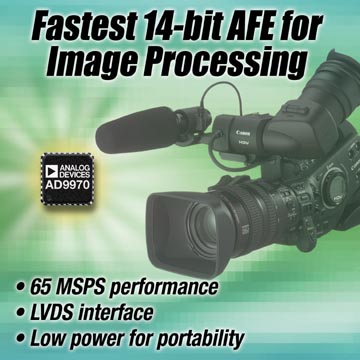Canon selects ADI's AD9970 analog front end to enable its HDV camcorder.
Analog Devices Inc. announced it is extending its portfolio of analog front ends (AFEs) for high-performance imaging applications with the introduction of a device that offers a 30 percent improvement in signal conversion performance, clocking at speeds up to 65 MSPS (mega samples per second) using very low power (155 mW), and a 75 percent reduction in board space. These aggressive performance, power and size specifications are necessary to capture high-definition (HD) content and enable the advanced capabilities that consumers are seeking in today’s HD camcorders. The company also announced that Canon has selected the AD9970 for their new HDV XL H1 camcorder, which enables high-quality video production at a cost accessible to numerous audiences, including commercial and general consumer users.
According to design engineers at Canon, the AD9970 was instrumental in allowing the company to reduce component count and power consumption without sacrificing a brilliant HD image. Analog Devices’ technical excellence and design expertise enabled Canon to meet the demanding image processing requirements needed to provide a high-quality solution for its next-generation HDV XL H1 camcorder.
Designed for consumer imaging products such as camcorders and digital still cameras, the AD9970 serves as a complete AFE consisting of a CDS (correlated double sampler), a variable gain amplifier, an ADC (analog-to-digital converter), as well as a high-performance programmable timing driver. Each component plays a role in conditioning and digitizing the signal from the CCD. The AD9970 is also one of the first AFEs on the market to use a LVDS (low-voltage differential signaling) interface for high-definition imaging equipment. This feature significantly reduces the number of high-speed data outputs, resulting in a smaller package, increased performance and reduced cost required to shield for EMI (electromagnetic interference). Too much EMI in an electronic system can result in harmful interference in radio communications and must be either eliminated or reduced within a certain level or the product cannot be sold under rules enforced by the FCC (Federal Communications Commission).
About the AD9970 Analog Front End
The AD9970 consists of a 14-bit ADC operating at a very low-power dissipation of 155 mW at 65 MSPS. Also incorporated in the device are a VGA (variable gain amplifier) and CDS, which are responsible for conditioning and digitizing the signal. The programmable timing driver, dubbed Precision TimingTM, further increases performance by enabling precise and localized control of high-speed CCD clock signals. An LVDS interface, responsible for handling the signal output, reduces EMI shielding requirements and significantly reduces package size (5 mm x 5 mm).
Availability and Pricing
The AD9970 AFE is available now in full production. The device is priced at $10.74 per unit in 1,000-piece quantities in a space-saving 5 mm x 5 mm LFCSP (lead-frame chip-scale package) and is specified over an operating temperature range of –25°C to +85°C.